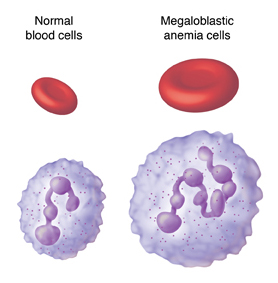When Your Child Has Megaloblastic Anemia
Megaloblastic anemia occurs when there are not enough healthy red blood cells (RBCs) in the body. RBCs are important. They contain a protein called hemoglobin. Hemoglobin allows the blood to carry oxygen to all parts of the body. A child with this condition may feel very tired. They may have less energy than normal. Without treatment, symptoms can be severe. They can cause health problems. Your child's healthcare provider can evaluate your child. They will talk about treatment options with you.
 |
| With megaloblastic anemia, red and white blood cells are too large. |
What causes megaloblastic anemia?
This condition is most often due to a lack of folate or vitamin B-12. Possible causes of this include:
-
Too little folate or vitamin B-12 in the diet. This is more common in children who are vegetarian, vegan, or drink only goat's milk.
-
Some conditions that affect the digestive system. These conditions can affect how well the body absorbs folate or vitamin B-12. They include Crohn's disease or celiac disease.
-
Some medicines. These can affect how well the body absorbs folate.
-
Lack of a special protein in the stomach. This protein (intrinsic factor) helps the body absorb vitamin B-12.
-
Other conditions. Less common causes include hypothyroidism, some blood cancers, and some blood cell disorders.
What are the symptoms?
Symptoms can range from mild to severe. But some children have no symptoms. Symptoms may include:
-
Pale skin
-
Crankiness
-
Weakness
-
Extreme tiredness (fatigue)
-
Shortness of breath
-
Dizziness
-
Trouble with balance, coordination, or memory (neurologic problems)
-
Digestive problems such as nausea, vomiting, constipation, diarrhea, or loss of appetite
How is it diagnosed?
Your child will likely see a pediatric hematologist for diagnosis and treatment. This is a healthcare provider who specializes in blood disorders (hematology). The provider will check your child. They will ask about their symptoms, medicines, diet, and health history. Tests are also done. Most of the tests include taking a blood sample. This is done from a vein in the arm or from a finger or heel. Tests may include:
-
Complete blood count (CBC). This test measures the amounts of types of cells in the blood.
-
Blood smear. This test checks the size and shape of blood cells. A drop of blood is examined under a microscope. A stain is used to make parts of the blood cells easier to see. With this anemia, the RBCs are too large. They may not have formed correctly.
-
Reticulocyte count. This test measures the amount of new RBCs being made by the bone marrow.
-
Other blood tests. These are done to check folate and vitamin B-12 levels.
-
Bone marrow biopsy. This is done if other tests don't give a clear diagnosis. It tests for less common causes.
How is it treated?
Treatment depends on the cause and severity of symptoms. Common treatments include:
-
Diet changes. These are done to increase the folate or vitamin B-12 in your child's diet. Foods rich in B-12 and folate include eggs, meat, fish, poultry, and milk. Ask your child's healthcare provider for more nutrition resources, if needed. They can also refer you to a nutritionist.
-
Folate or vitamin B-12 pills or shots (injections). These are prescribed by the provider.
-
Medicines or other treatments. These may be needed if the anemia is caused by something other than folate or vitamin B-12 deficiency.
What are the long-term concerns?
With treatment, most children with this condition can manage their condition. They can then be as active and independent as other children. Ongoing treatment with folate or vitamin B-12 may be needed. Your child may need to see their healthcare provider often for routine tests and help in managing symptoms.
Online Medical Reviewer:
Adam Levy MD
Online Medical Reviewer:
Dan Brennan MD
Online Medical Reviewer:
Jessica Gotwals RN BSN MPH
Date Last Reviewed:
12/1/2022
© 2000-2025 The StayWell Company, LLC. All rights reserved. This information is not intended as a substitute for professional medical care. Always follow your healthcare professional's instructions.